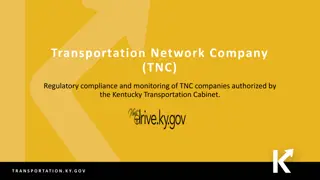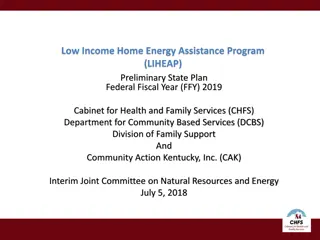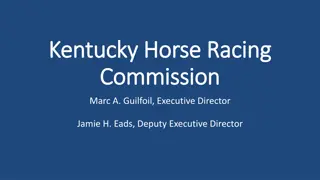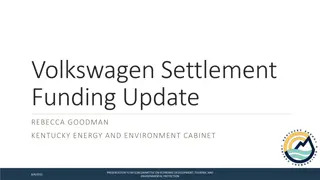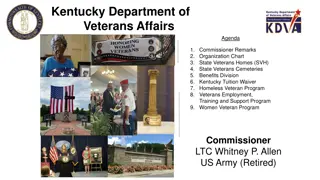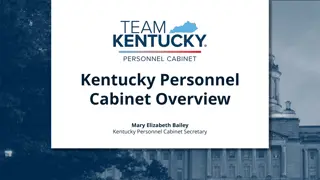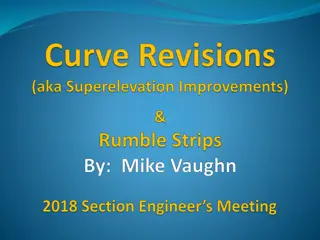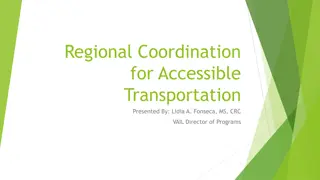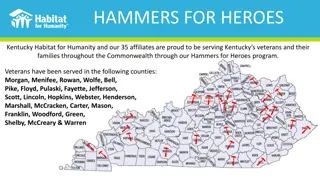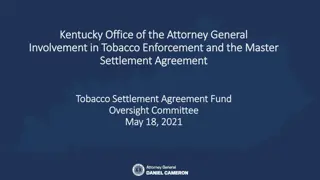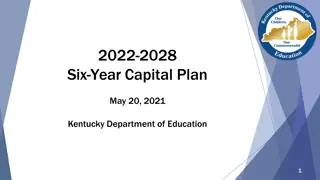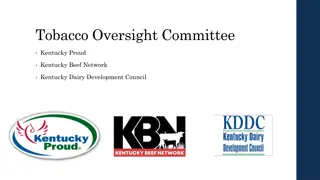Understanding Title VI: Expectations and Responsibilities in Kentucky Transportation Cabinet
Explore the key components of Title VI including authorities, compliance, and protected classes under the Civil Rights Act of 1964. Learn about the Federal Aid Highway Act and other nondiscrimination laws and executive orders relevant to ensuring equal access to programs receiving federal financial assistance.
Download Presentation

Please find below an Image/Link to download the presentation.
The content on the website is provided AS IS for your information and personal use only. It may not be sold, licensed, or shared on other websites without obtaining consent from the author. Download presentation by click this link. If you encounter any issues during the download, it is possible that the publisher has removed the file from their server.
E N D
Presentation Transcript
TITLE VI: EXPECTATIONS TITLE VI: EXPECTATIONS AND RESPONSIBILITIES AND RESPONSIBILITIES KENTUCKY TRANSPORTATION CABINET OFFICE FOR CIVIL RIGHTS AND SMALL BUSINESS DEVELOPMENT 200 Mero Street Frankfort, KY 40622 Phone: (502) 564-3601 Fax: (502) 564-1491
Objectives Understand Title VI Authorities/Law Understand compliance with Title VI Discuss Components of a Title VI Implementation/Program Plan
What is Title VI Federal Law The Civil Rights Act of 1964 No person in the United States shall on the ground of race, color,or national origin be excluded from participation in, be denied the benefits of, or be subjected to discrimination under any program or activity receiving Federal financial assistance. (42 U.S.C. 2000d)
Who is Protected? Title VI applies to all persons. Courts have interpreted the Equal Protection Clause of the Fourteenth Amendment and analogous language in civil rights laws to mean that Title VI protects all persons in the United States. Applies to direct and indirect effects on those persons.
Federal Aid Highway Act Section 162(a) of the Federal-Aid Highway Act of 1973 (23 U.S.C. 324) The FHWA regulations at 23 CFR 200.5(p) refer to the FHWA Title VI Program that covers Title VI requirements and requirements of other civil rights provisions to the extent that they prohibit discrimination on the grounds of race, color, sex, or national origin in programs receiving Federal financial assistance of the type subject to Title VI itself.
Title VI Protected Classes Race Color National Origin Sex
Nondiscrimination Laws and Executive Orders Civil Rights Act of 1964* Federal Aid Highway Act (1973) Civil Rights Restoration Act (1987) Rehabilitation Act (1973) American with Disabilities Act (1991) Age Discrimination Act (1975) Executive Order 13166: Limited English Proficiency (LEP) Executive Order 12898: Environmental Justice (EJ)
What is Discrimination? The act (action or inaction), whether intentional or unintentional, through which a person in the U.S., solely because of distinguishing protected attributes, is subjected to disparate treatment or impact, in any program or activity receiving Federal financial assistance from FHWA Under 23 U.S.C.
Types of Discrimination Denial of program services, financial aid, or benefits Providing different types of program services, financial aid Providing group services in a different manner Segregating or separately treating individuals or groups in any matter relating to the receipt of any program service, financial aid or benefit Imposing impacts to groups for the benefit of another group
Disparate Treatment When similarly situated persons are treated differently because of their race, color, national origin, or sex.
Disparate Impact Refers to actions in which the recipient in violation of agency regulations, uses a facially neutral procedure or practice that has adverse effects on members of a group based on race, color, national origin, or sex; and such practice lacks a substantial legitimate justification.
Minority & Women Representation on Planning Boards & Commissions Including minorities and women on planning boards and commissions is key for creating an equal access planning system. Sub-recipients cannot deny someone the opportunity to participate as a member of a planning or commission board.
Compliance Who MUST comply? Recipients of federal financial aid must comply with the various Title VI nondiscrimination laws and regulations. A recipient is any entity or individual to whom Federal assistance is provided (23 CFR 200.5(n)). Sub-recipients and contractors, regardless of tier, are REQUIRED to prevent discrimination and ensure nondiscrimination in all of their programs and activities.
Compliance Federal aid or Federal assistance can be in the form of: A grant and direct funding Grant or donation of Federal property Equipment and training Detail of Federal personnel Sale, lease, permission to use Federal property
Compliance In order to be in compliance with Title VI sub-recipients and contractors must: Appoint a Title VI Coordinator Develop a Title VI Implementation Plan Limited English Proficiency Environmental Justice Public Participation Plan Provide Title VI training for employees Develop a Title VI Policy Statement Have signed Title VI Assurances Have a grievance/complaint procedure in place Monitor sub-recipients and sub-contractors for Title VI compliance
Compliance Development of Title VI Implementation Plan The plan communicates how the organization/agency will implement Title VI requirements such as LEP and EJ. The plan also discusses procedures, strategies, activities and goals to ensure nondiscrimination. Identifies the Title VI Coordinator. Contains the complaint procedures, Title VI Policy Statement and signed Assurances.
Compliance Limited English Proficiency (LEP) Executive Order 13166 requires Federal agencies, including those agencies who receive Federal funds, to examine the services they provide identify any need for services to those with Limited English Proficiency (LEP) and develop and implement a system to provide those services so LEP persons can have meaningful access to them.
Compliance In order to determine the most effective way to service LEP populations in your area a Four Factor Analysis needs to be conducted. 1. Number of LEP persons eligible to be served or likely to be encountered by the program or recipient. 2. Frequency with which LEP Persons come into contact with your program. 3. The nature and importance of the program, activity or service provided by the program to people s lives. 4. The resources available to the recipient for LEP outreach, as well as the cost associated with that outreach.
Compliance Safe Harbor Provision means that if an organization/agency provides written translations under this provision, such action will be considered strong evidence of compliance with the organization/agency written translation obligations. Safe Harbor applies to the translation of written documents ONLY Safe Harbor requires written translations of vital (critical) documents for LEP group that meets the threshold
Compliance Safe Harbor for written translations:
Compliance Environmental Justice Executive Order 12898, Federal Actions to Address Environmental Justice in Minority Populations and Low- Income Populations, addresses disproportionate adverse environmental, social and economic impacts that may exist in communities, specifically minority and low-income populations.
Noncompliance If a recipient is found to be noncompliant by FHWA the following sanctions can occur: Federal informal action Federal corrective action plan Federal funding termination Federal government can terminate funding for actual or threatened non-compliance
Noncompliance If the sub-recipient is found to be noncompliant by KYTC the following sanctions can occur: State informal action State corrective action plan Financial penalties for responsible entities o Withhold funding o Termination or suspension of the contract/grant in whole or in part






